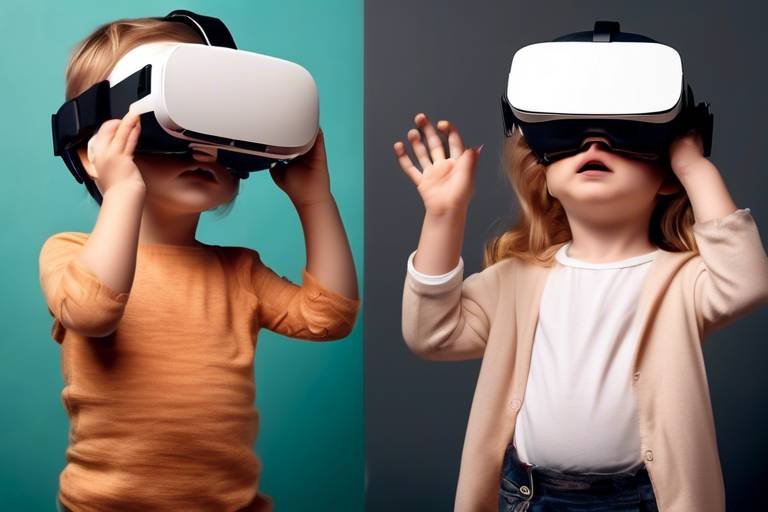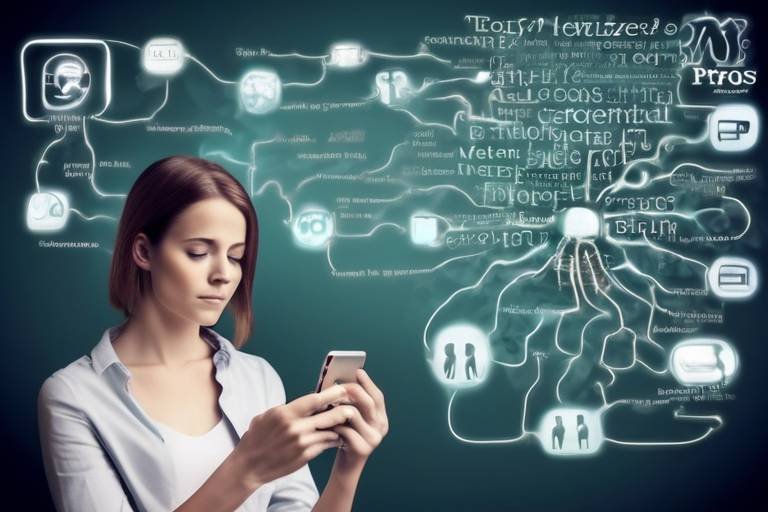The Influence of Virtual Reality on Empathy Development
In a world that often feels divided, the quest for understanding and empathy has never been more critical. Imagine stepping into someone else's shoes—experiencing their joys, struggles, and the nuances of their daily lives. This is where Virtual Reality (VR) steps in, transforming the way we connect with one another. By immersing users in diverse perspectives, VR technology has the potential to foster a deeper understanding of others' emotions and situations. But how does this technology work its magic? Let's dive into the science behind empathy and explore the remarkable ways VR can enhance our ability to empathize with others.
To appreciate the impact of VR on empathy, we first need to understand what empathy truly is. At its core, empathy is the ability to recognize and share the feelings of others. Psychologically, it involves a complex interplay of emotional and cognitive processes. Neurologically, studies have shown that specific brain regions, such as the anterior insula and anterior cingulate cortex, are activated when we empathize with others. These areas are responsible for emotional awareness and processing social information.
Several factors can influence empathy development, including:
- Personal experiences: Our backgrounds shape how we perceive others' emotions.
- Social interactions: Engaging with diverse groups can enhance our empathetic skills.
- Education: Learning about different cultures and perspectives fosters understanding.
By leveraging VR technology, we can create environments that simulate these experiences, allowing users to step into the shoes of others like never before.
Virtual reality is not just a tool for entertainment; it’s a powerful medium for empathy enhancement. Imagine donning a VR headset and finding yourself in a bustling city as a refugee, navigating the challenges they face daily. Such immersive experiences can evoke emotional responses that traditional methods simply cannot achieve. VR allows users to engage with scenarios that reflect real-life situations, breaking down barriers and fostering a profound connection to others' experiences.
Numerous case studies have emerged, showcasing the effectiveness of VR in empathy training. For instance, a program called “The Empathy Machine” has been implemented in various educational and corporate settings. Participants reported feeling a significant emotional connection to the experiences they witnessed through VR. These programs have demonstrated that when individuals are placed in immersive environments, their ability to empathize increases dramatically.
In schools and universities, VR is being utilized to teach empathy through experiential learning. Imagine students exploring different cultures or historical events through the eyes of those who lived them. This not only enhances their understanding but also cultivates compassion and a sense of shared humanity. Programs that incorporate VR into their curriculum are paving the way for a new generation that values empathy as a vital skill.
Many organizations are now recognizing the value of empathy in the workplace. By integrating VR into their training programs, companies are helping employees understand their colleagues' perspectives better. This approach not only improves workplace relationships but also enhances teamwork and collaboration. When employees can empathize with one another, it leads to a more harmonious and productive work environment.
Beyond education and corporate training, VR has the power to drive social change. Initiatives aimed at raising awareness about marginalized communities have successfully utilized VR experiences to promote understanding. By immersing users in the realities faced by these communities, VR can challenge stereotypes and foster a sense of connection that leads to advocacy and support.
Despite its potential, using VR for empathy development is not without challenges. Issues such as accessibility, technological limitations, and ethical considerations must be addressed. For instance, not everyone has access to the latest VR technology, which can create disparities in who benefits from these programs. Additionally, the ethical implications of simulating traumatic experiences must be carefully considered to avoid causing distress to users.
The effectiveness of VR in developing empathy largely depends on user experience. Factors such as the quality of the VR content, user interface, and the overall engagement level can significantly impact outcomes. Optimizing these elements is crucial to ensure that users are fully immersed and able to connect emotionally with the experiences presented.
Finally, evaluating the success of VR programs in fostering empathy is essential. Various methods and tools can be employed to measure empathy development in participants after their VR experiences. Surveys, interviews, and observational studies can provide insights into how effectively these programs enhance empathetic responses.
1. How does VR enhance empathy?
VR creates immersive experiences that allow users to experience situations from different perspectives, fostering emotional connections and understanding.
2. Are there any risks associated with VR empathy training?
Yes, potential risks include emotional distress from experiencing traumatic scenarios and accessibility issues for those without access to the technology.
3. Can VR be used in therapy?
Absolutely! VR is increasingly being used in therapeutic settings to help individuals confront and process their emotions in a controlled environment.
4. What are some successful examples of VR empathy programs?
Programs like “The Empathy Machine” and various educational initiatives have shown promising results in enhancing empathy among participants.

The Science Behind Empathy
Understanding the psychological and neurological basis of empathy is crucial to grasping how we connect with one another. Empathy is not just a fleeting emotion; it's a complex interplay of cognitive and affective processes that allow us to resonate with the feelings and experiences of others. At its core, empathy involves two main components: cognitive empathy, which is the ability to understand another person's perspective, and emotional empathy, which refers to the capacity to share and respond to another's emotional state. These components work together to create a rich tapestry of human connection.
Research in neuroscience has revealed that certain areas of the brain are particularly active when we engage in empathetic responses. The mirror neuron system, for instance, plays a pivotal role in our ability to mimic and understand others' actions and emotions. When we see someone experiencing joy or pain, our brain mirrors that experience, allowing us to feel a semblance of what they are going through. This neurological wiring is essential for social bonding and emotional intelligence.
Moreover, various factors influence the development of empathy in individuals. These factors can be broadly categorized into:
- Biological Factors: Genetics and brain structure can predispose individuals to higher levels of empathy.
- Environmental Influences: Childhood experiences, cultural background, and social interactions shape how we develop empathy.
- Education and Training: Programs that focus on emotional intelligence can enhance empathetic skills.
Interestingly, empathy is not a static trait; it can be cultivated and expanded over time. Studies have shown that engaging in practices like mindfulness and active listening can significantly boost our empathetic abilities. When we take the time to genuinely listen to others and reflect on their experiences, we not only enhance our understanding but also deepen our connections with them. This is where virtual reality comes into play, offering a groundbreaking method to immerse ourselves in the experiences of others and expand our empathetic horizons.
In summary, the science behind empathy is a fascinating blend of biology, psychology, and social interaction. By understanding the mechanisms that underpin empathy, we can better appreciate its significance in our lives and the potential for technologies like VR to enhance this vital human trait.

Imagine slipping on a headset and suddenly finding yourself in a bustling market in a different country, feeling the heat of the sun and hearing the chatter of locals around you. This is the magic of Virtual Reality (VR), a technology that transcends the boundaries of our physical world and immerses us in experiences that can profoundly shape our understanding of others. VR acts as a powerful empathy tool by allowing users to step into the shoes of different individuals, experiencing their lives, challenges, and emotions firsthand. This immersive quality can create a visceral understanding of situations that might seem distant or abstract in our daily lives.
At its core, VR technology harnesses the ability to simulate real-life scenarios, engaging multiple senses and creating a sense of presence that is difficult to achieve through traditional media. By embodying another person's perspective, users can develop a deeper emotional connection, which is essential for fostering empathy. For instance, a VR experience might allow a user to experience the world as a refugee fleeing conflict, or as a person living with a disability navigating everyday challenges. These scenarios can evoke powerful emotional responses, leading to greater compassion and understanding.
Research has shown that immersive experiences in VR can lead to significant changes in attitudes and behaviors. In one study, participants who engaged in VR simulations that portrayed the lives of marginalized communities reported a marked increase in empathy towards those groups. The emotional impact of these experiences can be far more profound than simply reading about someone else's struggles or watching a documentary. This is because VR engages the brain in a way that makes the experiences feel real, creating a lasting impression that can influence how we perceive and interact with others in our lives.
Moreover, VR can be tailored to target specific issues or themes, making it a versatile tool for various applications. For instance, educational institutions are beginning to incorporate VR into their curricula, allowing students to engage with complex social issues in a controlled environment. In corporate settings, VR is being utilized to enhance diversity training, helping employees understand the experiences of their colleagues from different backgrounds. By providing a safe space to explore these themes, VR encourages open dialogue and reflection, which are crucial for personal growth and understanding.
However, it’s important to recognize that the effectiveness of VR as an empathy tool hinges on its design and execution. The narratives crafted within VR experiences need to be authentic and respectful, ensuring that they accurately represent the lives and struggles of the individuals being portrayed. When done correctly, the potential for VR to foster empathy is immense, paving the way for more compassionate societies.

In recent years, several compelling case studies have emerged that showcase the transformative power of Virtual Reality (VR) in fostering empathy among diverse groups. These studies illustrate how immersive experiences can bridge the gap between different perspectives, allowing users to step into the shoes of others in profound ways. For instance, a notable program implemented in a healthcare setting utilized VR to simulate the experiences of patients with chronic pain. Participants donned VR headsets and navigated through a day in the life of these patients, facing the physical and emotional challenges they encounter. The results were striking; healthcare professionals reported a significant increase in their understanding and compassion towards their patients' struggles.
Another intriguing case study took place in a school environment, where educators used VR to teach students about the lives of refugees. Through a series of immersive experiences, students were able to witness the challenges faced by individuals fleeing their home countries. This not only enhanced their knowledge but also sparked meaningful conversations about empathy and social justice among peers. The educators noted a marked improvement in students' willingness to engage with and support their classmates from diverse backgrounds.
Moreover, corporations are also leveraging VR for empathy training. A leading tech company developed a VR program aimed at enhancing teamwork and communication among its employees. By placing employees in scenarios that required collaboration while experiencing the challenges faced by their colleagues, the program fostered a deeper understanding of different roles within the company. Participants reported feeling more connected to their teammates, which ultimately improved workplace dynamics.
These case studies highlight the versatility of VR as an empathy training tool across various sectors. They demonstrate that when individuals are given the opportunity to experience life from another's perspective, it can lead to profound shifts in attitudes and behaviors. The immersive nature of VR not only captivates the user’s attention but also creates lasting emotional connections that traditional training methods often fail to achieve.
As we delve deeper into the potential of VR for empathy training, it becomes evident that the technology is not just a tool for entertainment; it’s a powerful medium for social change. The ability to create shared experiences can lead to greater understanding and compassion in our increasingly divided world.
- What is VR empathy training? VR empathy training involves using virtual reality technology to immerse users in experiences that help them understand the emotions and challenges faced by others.
- How effective is VR in developing empathy? Research indicates that VR can significantly enhance empathetic responses by providing immersive, first-person perspectives that foster emotional connections.
- Are there any limitations to VR empathy training? Yes, challenges such as accessibility, technological limitations, and ethical considerations need to be addressed to maximize the effectiveness of VR in empathy development.

The integration of Virtual Reality (VR) into educational settings is revolutionizing how students learn and interact with complex concepts. Imagine stepping into a historical event or exploring the inner workings of the human body without leaving the classroom. This immersive technology allows students to experience lessons in a way that traditional methods simply cannot match. By placing learners in realistic scenarios, VR not only enhances engagement but also deepens understanding and empathy.
One of the most significant advantages of VR in education is its ability to provide experiential learning opportunities. For instance, students can participate in virtual field trips to places like ancient Rome or the Amazon rainforest, allowing them to see and feel what it’s like to be in these environments. This type of learning goes beyond textbooks, fostering a connection that can lead to a greater appreciation of diverse cultures and ecosystems. In fact, studies have shown that students who engage in VR experiences tend to retain information better and develop a more nuanced perspective on the subjects they study.
Moreover, VR can be particularly beneficial in teaching empathy. Programs designed to simulate the experiences of individuals from different backgrounds or those facing hardships can profoundly impact students. For example, a VR module might allow students to experience life as a refugee, navigating challenges that come with displacement. Such experiences can spark discussions and reflections that are crucial for developing a compassionate worldview.
To illustrate the impact of VR in education, consider the following table that outlines some successful VR applications in various educational institutions:
| Institution | Program | Outcome |
|---|---|---|
| Stanford University | Virtual Human Interaction Lab | Increased empathy towards marginalized groups |
| University of Maryland | VR for History Lessons | Improved engagement and retention of historical facts |
| Gonzaga University | Empathy Training for Healthcare Students | Enhanced patient communication skills |
As educators continue to explore the potential of VR, the possibilities seem limitless. Schools and universities are not only adopting this technology for its novelty but also for its proven effectiveness in fostering a deeper understanding of complex social issues. By immersing students in real-world scenarios, VR can cultivate a generation of learners who are not just knowledgeable but also empathetic. This shift towards experiential learning is essential in preparing students to navigate an increasingly interconnected world.
In conclusion, the educational applications of VR are transforming traditional learning paradigms. By providing immersive experiences that evoke emotional responses, VR is not just teaching facts; it's shaping the future of education by promoting empathy and understanding among students. As we continue to harness this innovative technology, we can look forward to a more compassionate and informed society.
- What is Virtual Reality (VR)? VR is a technology that creates a simulated environment, allowing users to interact with a 3D space as if they were physically present.
- How does VR enhance empathy in education? VR immerses students in different perspectives and experiences, helping them understand and relate to the emotions and situations of others.
- Are there any challenges associated with using VR in education? Yes, challenges include accessibility, technological limitations, and the need for proper training for educators to effectively implement VR experiences.
- Can VR be used for subjects other than social studies? Absolutely! VR can be applied across various subjects, including science, literature, and art, enhancing engagement and understanding.

In today's fast-paced corporate world, fostering a culture of empathy is more important than ever. Companies are beginning to realize that empathy is not just a soft skill but a crucial component of effective teamwork and leadership. With the advent of virtual reality (VR), organizations are discovering innovative ways to integrate this technology into their training programs. Imagine stepping into the shoes of a colleague or a customer, experiencing their challenges and emotions firsthand. This immersive approach allows employees to gain a profound understanding of diverse perspectives, ultimately enhancing workplace relationships.
One of the most compelling aspects of VR in corporate training is its ability to create realistic scenarios that employees might encounter in their daily roles. For instance, a retail employee can engage in a VR simulation where they interact with a frustrated customer. This not only helps them practice their response strategies but also cultivates a sense of compassion and understanding towards the customer’s situation. The result? Employees who are better equipped to handle real-life interactions with empathy and professionalism.
Moreover, companies are leveraging VR to address unconscious biases within their teams. By immersing employees in experiences that highlight the challenges faced by marginalized groups, organizations can foster a more inclusive workplace. Consider a VR program that allows employees to experience a day in the life of someone from a different background. This not only raises awareness but also encourages discussions about diversity and inclusion, leading to a stronger, more cohesive team.
To illustrate the effectiveness of VR in corporate training, let’s take a look at some successful implementations:
| Company | Program Focus | Outcome |
|---|---|---|
| Salesforce | Empathy in Customer Service | Improved customer satisfaction ratings by 30% |
| Accenture | Diversity and Inclusion | Increased awareness and reduced bias in hiring processes |
| Unilever | Leadership Development | Enhanced collaboration and communication among teams |
As these examples demonstrate, the integration of VR into corporate training programs is not just a trend; it’s a transformative approach that yields tangible results. Employees who undergo VR training report feeling more connected to their colleagues and more capable of understanding their needs. This shift in mindset can lead to improved teamwork, higher morale, and ultimately, a more productive work environment.
However, to maximize the benefits of VR training, organizations must ensure that the technology is accessible to all employees. This includes providing adequate training on how to use the equipment and ensuring that VR experiences are designed to be inclusive and representative of the diverse workforce. As companies continue to invest in VR for empathy development, the potential for positive change within corporate cultures is boundless.
In conclusion, corporate training programs that incorporate virtual reality are paving the way for a new era of empathy in the workplace. By allowing employees to experience situations from different viewpoints, VR not only enhances interpersonal skills but also creates a more understanding and collaborative environment. As we move forward, embracing this technology will be essential for organizations aiming to foster a culture of empathy and inclusivity.

Virtual reality (VR) isn't just a technological marvel; it's a powerful tool for driving social change. Imagine stepping into someone else's shoes—feeling their struggles, experiencing their joys, and understanding their world. VR can create these immersive experiences that foster empathy towards marginalized communities, allowing users to connect with individuals and situations they might never encounter in their daily lives.
One of the most remarkable aspects of VR is its ability to transport users into the heart of social issues. For instance, initiatives like “The Displaced” by The New York Times allow users to experience the lives of refugees. Through VR, users can walk alongside individuals fleeing their homes, witnessing the challenges they face. This direct engagement cultivates a profound emotional connection, pushing users to reconsider their perceptions and attitudes toward refugees.
Moreover, VR can be instrumental in addressing issues like racial inequality, gender discrimination, and mental health stigma. By simulating real-life scenarios, VR can help users understand the emotional and psychological impacts of these social issues. For example, programs that immerse users in the experiences of individuals from different racial backgrounds can challenge preconceived notions and biases, promoting a deeper understanding of systemic injustices.
In addition to experiential learning, VR can serve as a platform for advocacy and activism. Organizations can use VR to create impactful narratives that highlight social issues, mobilizing support and encouraging action. The immersive nature of VR storytelling can evoke strong emotional responses, making users more likely to engage with and advocate for social change.
However, the effectiveness of VR in promoting social change depends on how these experiences are designed. It’s crucial that developers create authentic and respectful representations of the communities they aim to portray. This ensures that VR experiences do not perpetuate stereotypes but rather foster understanding and compassion.
In summary, VR holds immense potential as a catalyst for social change. By immersing users in the realities of others, it can break down barriers, challenge biases, and inspire empathy. As more organizations and creators harness this technology, we may witness a shift in societal attitudes, paving the way for a more compassionate world.
- How does VR enhance empathy?
VR enhances empathy by immersing users in experiences that allow them to see the world from others' perspectives, fostering emotional connections and understanding.
- Can VR be used in educational settings?
Yes, VR is increasingly being used in educational environments to teach empathy through experiential learning, helping students understand diverse perspectives.
- What are some challenges of using VR for empathy development?
Challenges include accessibility issues, technological limitations, and the need for ethical considerations in representing marginalized communities.
- How can the effectiveness of VR in promoting empathy be measured?
Effectiveness can be measured through various methods, including surveys, interviews, and observational studies to assess changes in attitudes and behaviors post-experience.

While the potential of virtual reality (VR) as a tool for enhancing empathy is immense, it is crucial to recognize that there are several challenges associated with its implementation. These challenges can hinder the effectiveness of VR experiences in fostering true empathetic understanding among users. Let's explore some of the most significant hurdles that need to be addressed.
One of the primary challenges is accessibility. Not everyone has access to the latest VR technology or the necessary hardware to experience these immersive environments. This can create a divide where only certain groups, often those who are already privileged, can benefit from VR empathy training. Imagine trying to build bridges of understanding in a community where only a few can participate in the experience. This disparity not only limits the reach of VR programs but also risks reinforcing existing social inequalities.
Another significant hurdle is the technological limitations that come with VR. While the technology has advanced tremendously, issues such as motion sickness, discomfort from headsets, and the need for physical space can detract from the overall experience. Users may find themselves distracted by these discomforts, which undermines the core objective of fostering empathy. Furthermore, the quality of the VR content itself plays a critical role; poorly designed experiences can lead to frustration rather than understanding.
Ethical considerations also present a substantial challenge. As we delve into the emotional experiences of others through VR, we must tread carefully to avoid exploitation or misrepresentation of sensitive situations. For instance, creating a VR simulation that portrays a traumatic event for the sake of empathy training must be handled with the utmost care and respect. It’s essential to ensure that participants are not subjected to emotional distress without proper support and debriefing afterward.
Moreover, the user experience is pivotal in determining the success of VR in empathy development. If users do not feel engaged or emotionally connected to the experience, the intended impact may be lost. Factors such as the narrative quality, interactivity, and realism of the VR environment all contribute to how effectively empathy can be developed. VR experiences should be designed to captivate the user, drawing them into the story and allowing them to truly feel what others might experience.
In conclusion, while VR holds incredible potential for empathy development, addressing these challenges is vital. By focusing on making VR more accessible, overcoming technological limitations, considering ethical implications, and enhancing user engagement, we can pave the way for a future where virtual reality becomes a powerful ally in fostering empathy across diverse communities.
- What is virtual reality (VR)? VR is a simulated experience that can be similar to or completely different from the real world, often using headsets and other equipment to immerse users in a 3D environment.
- How can VR enhance empathy? VR allows users to experience situations from different perspectives, helping them to understand and connect with the emotions and experiences of others.
- What are some examples of VR used for empathy training? Programs that simulate experiences of marginalized communities or training modules for healthcare professionals are examples of VR applications aimed at enhancing empathy.
- What challenges does VR face in empathy training? Accessibility, technological limitations, ethical considerations, and user engagement are significant challenges that need to be addressed.

When it comes to virtual reality (VR) and its role in developing empathy, user experience is everything. Imagine putting on a VR headset and being transported into a world that feels so real, you can almost feel the emotions of the characters around you. This immersive experience is what makes VR such a powerful tool for fostering empathy. But how do we ensure that users are not just passively observing but actively engaging with the content? The answer lies in several key factors that enhance user experience.
First and foremost, immersion is crucial. The more lifelike a VR experience feels, the more likely users are to connect emotionally with the scenarios presented. Developers can achieve this by utilizing high-quality graphics, realistic sound effects, and interactive elements that allow users to make choices and experience consequences. For instance, a VR simulation that places users in the shoes of a refugee navigating a foreign city can evoke a strong emotional response, especially if users can interact with their environment.
Another important aspect is storytelling. Compelling narratives can draw users in and make them feel invested in the characters' journeys. When users can relate to a character’s struggles, their capacity for empathy expands. A well-crafted story can create a sense of urgency, prompting users to reflect on their own beliefs and biases. For example, a VR experience that tells the story of a marginalized community can challenge users to confront their preconceived notions and foster a deeper understanding of the challenges faced by others.
Additionally, feedback mechanisms play a vital role in enhancing user engagement. Providing users with real-time feedback about their choices and actions can help them understand the impact of their decisions on others. This can be as simple as visual cues or more complex systems that track emotional responses through biometric data. For instance, if a user chooses to help a character in distress, immediate positive feedback can reinforce the value of empathy and encourage users to continue engaging with similar scenarios.
However, it's not just about the technology; the design of the experience matters too. User-friendly interfaces and intuitive controls can significantly impact how users interact with VR. If users struggle with navigation or find the experience cumbersome, they may disengage, losing out on the potential benefits of the empathy training. Therefore, developers must prioritize creating seamless experiences that allow users to focus on the emotional journey rather than the mechanics of the technology.
Finally, the social aspect of VR cannot be overlooked. Engaging with others in a shared VR space can amplify the emotional experience. When users participate in group scenarios, they can discuss and reflect on their experiences together, leading to richer conversations and deeper insights. For example, a classroom setting where students experience a VR simulation together can spark discussions that enhance understanding and empathy among peers.
In summary, user experience and engagement are critical components in leveraging VR for empathy development. By focusing on immersion, storytelling, feedback mechanisms, design, and social interaction, we can create powerful experiences that not only captivate users but also foster a greater understanding of the human experience. As we continue to explore the potential of VR, it’s essential to keep these elements at the forefront to maximize its impact on empathy development.
- What is virtual reality (VR)?
VR refers to computer-generated simulations that allow users to experience and interact with a 3D environment, often using a headset. - How does VR enhance empathy?
By immersing users in different perspectives and experiences, VR allows them to feel emotions and understand situations from others' viewpoints. - What are some applications of VR in education?
VR is used in classrooms to simulate real-world scenarios, helping students develop empathy and social skills. - Are there any challenges to using VR for empathy training?
Yes, challenges include accessibility, technological limitations, and the need for ethical considerations in content creation.

Measuring the impact of virtual reality (VR) on empathy development is not just a matter of intuition; it requires a robust framework to assess outcomes effectively. Understanding how to quantify empathy can be complex, as it involves both subjective experiences and objective measurements. Researchers and practitioners have developed various methods to gauge the effectiveness of VR experiences in fostering empathy among participants.
One of the most common approaches is through the use of standardized empathy scales. These scales, such as the Interpersonal Reactivity Index (IRI) or the Empathy Quotient (EQ), allow researchers to evaluate changes in empathy levels before and after VR experiences. Participants typically complete these assessments immediately after the VR session and then again after a certain period to measure any lasting effects. The results can reveal significant insights into how immersive experiences influence emotional understanding and perspective-taking.
In addition to standardized scales, qualitative feedback plays a crucial role in measuring empathy outcomes. Participants often share their personal reflections on the VR experience, which can provide valuable context to the quantitative data. This feedback can be gathered through interviews, focus groups, or open-ended survey questions. Here, participants might describe how the VR experience affected their feelings towards others or changed their perceptions of social issues. These narratives can be incredibly powerful, highlighting the emotional transformations that numbers alone cannot capture.
Furthermore, researchers are increasingly utilizing physiological measures to assess empathy outcomes. Techniques such as heart rate variability, skin conductance, and even brain imaging can provide objective data on participants' emotional responses during and after VR experiences. For example, a decrease in heart rate while experiencing a VR scenario that evokes empathy may indicate a calming effect, suggesting a deeper emotional engagement with the content. These physiological markers can be particularly useful in corroborating self-reported data and offering a more comprehensive view of how VR impacts empathy.
To illustrate these methods, consider the following table that summarizes different approaches to measuring empathy outcomes:
| Method | Description | Strengths | Limitations |
|---|---|---|---|
| Standardized Scales | Pre- and post-experience assessments to measure empathy levels. | Quantifiable data, easy to analyze. | May not capture nuanced emotional changes. |
| Qualitative Feedback | Participant reflections and narratives about their experiences. | Rich, detailed insights into emotional impact. | Subjective and harder to quantify. |
| Physiological Measures | Measurement of bodily responses (heart rate, skin conductance). | Objective data that can validate self-reports. | Requires specialized equipment and expertise. |
Ultimately, the goal of measuring empathy outcomes in VR is to understand its effectiveness as a tool for social change and personal development. By combining various methods—quantitative assessments, qualitative feedback, and physiological data—researchers can paint a more holistic picture of how virtual reality shapes empathy. This comprehensive approach not only enhances the credibility of the findings but also informs future VR designs aimed at fostering deeper emotional connections among users.
- What is empathy? Empathy is the ability to understand and share the feelings of another person, allowing for deeper social connections.
- How does VR enhance empathy? VR creates immersive experiences that allow users to step into someone else's shoes, fostering a greater understanding of their emotions and situations.
- Are there any risks associated with using VR for empathy training? Yes, potential risks include emotional distress from confronting difficult subjects and the need for proper guidance during experiences.
- Can empathy be measured accurately? While it is challenging, combining quantitative and qualitative methods can provide a more accurate assessment of empathy development.
Frequently Asked Questions
- What is virtual reality (VR) and how does it relate to empathy?
Virtual reality (VR) is a technology that creates a simulated environment, allowing users to immerse themselves in experiences that feel real. When it comes to empathy, VR can help individuals understand and feel the emotions of others by placing them in diverse perspectives and situations. This immersive experience can lead to a deeper emotional connection and understanding of different life circumstances.
- Can VR really enhance empathy?
Absolutely! Research has shown that VR can significantly enhance empathy by providing users with experiences that they might not encounter in their daily lives. By experiencing scenarios from another person's viewpoint, users can develop a greater understanding of their feelings and challenges, which can foster a more empathetic attitude towards others.
- What are some examples of VR applications for empathy training?
There are numerous applications of VR in empathy training. For instance, educational institutions have implemented VR programs that allow students to step into the shoes of individuals from different backgrounds. Similarly, corporate training programs use VR to help employees understand the perspectives of their colleagues, enhancing teamwork and communication.
- What challenges exist in using VR for empathy development?
While VR has great potential, there are challenges to consider. Accessibility can be an issue, as not everyone has access to the necessary technology. Additionally, there are ethical considerations regarding the content of VR experiences and how they may affect users emotionally. Technological limitations can also impact the quality of the experience, which is crucial for effective empathy development.
- How do we measure the effectiveness of VR in developing empathy?
Measuring the effectiveness of VR experiences in fostering empathy can be done through various methods, such as pre- and post-experience surveys, behavioral observations, and emotional response assessments. These tools help researchers understand the impact of VR on participants' empathetic responses and whether the experiences truly resonate with them.



















